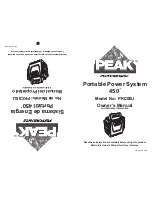
Battery information
There are numerous hazards associated with the use of rechargeable batter-
ies.
Always observe the following safety information when handling rechargeable
batteries.
In addition, ensure that you observe any additional safety information pro-
vided by the battery manufacturer.
a) Children
• Rechargeable batteries are not toys. Keep batteries out of the reach of children.
• Do not leave batteries lying around, as they constitute a choking hazard for children and
pets. Seek immediate medical advice if a battery is swallowed.
b) Handling
• Never wear metal or conductive objects (e.g. jewellery such as necklaces, bracelets or
rings) to avoid short circuits, which can lead to fire or explosion.
•
Rechargeable batteries must never be short-circuited, dismantled or thrown into fire. This
may cause a fire or explosion!
• When handling leaking or damaged batteries, always use suitable protective gloves to
avoid burning your skin.
•
Do not attempt to recharge disposable, non-rechargeable batteries. This may cause a fire
or explosion!
• Rechargeable batteries must not become damp or wet.
•
Place the charger and rechargeable battery on a non-flammable, heat-resistant surface
(e.g. stone tiles).
•
Keep the charger and battery away from flammable objects.
•
Maintain a sufficient distance between the charger and the battery.
• Never place the battery on top of the charger.
•
The battery may heat up during the charging process. Always ensure that there is sufficient
ventilation. Do not cover!
• Never use battery packs that are made of different types of cells.
• Never charge/discharge a battery when the charger is unattended.
• Never charge/discharge a rechargeable battery when it is inside a model. Remove the bat-
tery from the model before charging it.
• Always ensure that the battery is connected in the correct polarity (observe the plus/+ and
minus/- symbols). Connecting the battery incorrectly may damage the model and the bat-
tery and cause a fire or explosion!
• Do not charge a battery when it is still hot (e.g. due to a high discharge current in your mod-
el). Allow the battery to cool down to room temperature before charging or discharging it.
•
Never damage the casing of a rechargeable battery. This may cause a fire or explosion!
•
Never charge or discharge damaged, leaking or deformed batteries. This may cause a fire
or explosion!
• Disconnect the battery from the charger when the battery is fully charged.
• Rechargeable batteries should be charged at least once every 3 months to prevent damage
due to overdischarge.
c) Storage
• Store rechargeable batteries in a suitable location. Install a smoke detector in the room.
Batteries present a fire hazard and may generate toxic fumes. This applies in particular
to batteries for model toys, which are subjected to high charging/discharge currents and
vibrations.
d) Additional information about lithium rechargeable batteries
The following section provides an overview of the potential hazards associated with lithium bat-
teries and explains how these hazards can be avoided to ensure a long lifespan.
•
The casing of many lithium batteries is made of a thick film, which is very sensitive.
• Do not dismantle, drop or insert any objects into lithium batteries. Do not apply mechanical
loads or pull on the battery’s connection cables. This may cause a fire or explosion!
• Always observe these instructions when inserting or removing a battery from your model.
• Ensure that the battery does not overheat during use, recharging, discharging, transport or
storage. Do not place rechargeable batteries next to sources of heat (e.g. a speed controller
or motor) or expose them to direct sunlight. This may cause the battery to overheat, which
can cause a fire or explosion!
•
The temperature of the battery must not exceed 60 °C (or the maximum temperature stated
in the manufacturer’s instructions).
• If there are any signs of damage (e.g. if your model is subjected to an impact), or the battery
casing is swollen, discontinue use immediately. Do not attempt to recharge the battery, as
this may cause a fire or explosion!
• Exercise caution when handling the damaged battery and use suitable protective gloves.
Dispose of the battery in an environmentally friendly manner.
• Never store damaged batteries in an apartment or in a house/garage. Damaged or swollen
lithium batteries may catch fire.
• Always use a compatible charger to charge lithium batteries and ensure that the charging
specifications are correct. Do not use NiCd, NiMH or lead-acid battery chargers, as these
may cause a fire or explosion.
•
Always select the correct charging specifications for your rechargeable battery.
• Always use a balancer when charging a lithium battery with more than one cell (the charger
comes with a built-in balancer).
• The charge rate for LiPo batteries must not exceed 1 C (or the value stated in the battery
specifications). This means that the charging current must not exceed the battery capacity
(e.g. battery capacity = 1000 mAh, max. charging current = 1000 mA = 1 A).
•
Always refer to the manufacturer’s specifications when using LiFe, Li-ion and LiHV bat
-
teries.
• The discharge current must not exceed the value stated on the battery.
For example, if “20C” is printed on the LiPo battery, the maximum discharge current is 20
times the battery’s capacity (e.g. battery capacity = 1000 mAh, max. discharge current =
20C = 20 x 1000 mA = 20 A).
Exceeding the maximum current may cause the battery to overheat or become deformed,
which can lead to a fire or explosion!
The printed value (e.g. 20C) indicates the maximum current that the battery can deliver for a
short period. The continuous current should not be higher than one half of the stated value.
• Do not allow the individual cells of a lithium battery to become fully discharged. This may
destroy the battery or cause permanent damage.
• If your model does not have overdischarge protection or a low battery indicator, stop using
it before the battery becomes empty.






















